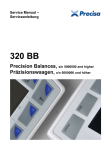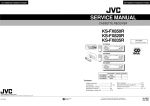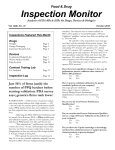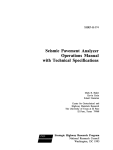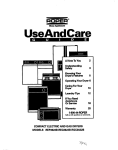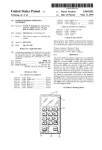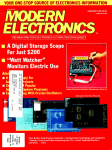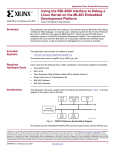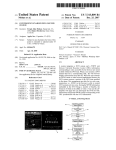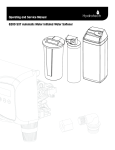Download Airplane mode indicator on a portable multifunction device
Transcript
US0081 16807B2 (12) United States Patent (10) Patent N0.: Matas (54) (45) Date of Patent: AIRPLANE MODE INDICATOR ON A (58) ( 73 ) (*) 455/520, 560, 566, 550-1; 370/310, 465 See application ?le for complete search history. Michael Matas, Palo Alto, CA (U S) (56) References Cited Assi nee: A le Inc. Cu ertino CA US g PP ’ p ’ ( ) Notice: Feb. 14, 2012 Field of Classi?cation Search ............... .. 455/903, PORTABLE MULTIFUNCTION DEVICE (75) Inventor: US 8,116,807 B2 OTHER PUBLICATIONS Subject to any disclaimer, the term of this patent is extended or adjusted under 35 Nokia, “Nokia 9000i Owner’s Manual,” Issue 1.1, 1997, 131 pages. Nokia, “Nokia 9000i User’s Manual,” Issue 2, Jun. 7, 1998, 126 U.S.C. 154(b) by 1087 days. Page$~ _ (21) Appl.No.:11/961,743 °at°rr6pagei (22) Filed: Primary Examiner * Dwayne Bost Assistant Examiner * Myron Wyche Dec. 20, 2007 (65) I (74) Attorney, Agent, or Firm * Morgan, Lewis & Bockius Prior Publication Data US 2008/0165146 A1 I Motorola, “A1000 Communicator, UMTSiUsmg Your Communi LLP Jul. 10, 2008 (57) ABSTRACT Related U-s- Application Data A graphical user interface on a portable multifunction device (60) Provisional application No 60/947 315 ?led on Jun 29 2007 Provisional application’ No.’ 60/937 993' .With a Pouch Screen display includes an airP1?“.1e mode Switch Icon Wlth an “on” posmon and an “Off, posmon' A Commu _ _ (51) _ nications signal strength icon is displayed if the airplane mode sWitch icon is at the “off” position. The communica tions signal strength icon is replaced With an airplane icon aPPhCaUOn No- 60/879,253: ?led 011 Jan- 7: 2007- upon detecting a movement of a ?nger contact on or near the Int- Cl- airplane mode sWitch icon. The detected movement of the ?nger contact is from the “off” position to the “on” position. H04M 1/00 (52) _ ?led on Jun‘ 29’ 2007’ provlslonal apphcanon NO‘ 6o/s79s469s ?led on Jan 8: 2007s Provisiona1 (2006.01) US. Cl. ................................... .. 455/550.1; 455/566 22 Claims, 14 Drawing Sheets Memmy Portable Multifunction Device 122 m :Operating System Module I123 I 126 A c ' ContectlMotion Module f Graphics Module f ' Module' J‘ I149 I Widget Modules I149 1 Weather Widget f149_2 Text Input Module 11:; Stocks Widget I14“ GPS Module I136 1‘ I14“ A f Alarm Clock Widget f Dictionary Widget E f Contacts Module Telephone Module Video Conference Module E-mail Client Module 131 I138 I139 I140 IInstant Messaging Module f 142 I143 Camera Module I144 Search Module Music Player Module I147 f P103 104 f 122 1 r 11a 162 Power System 124 PO" \ v~1ln_ RF Circuit m “’ 103 Controller S Peripherals Interface 120 _/ . 10a \ .7103 f 5 Image M Module f _ 145 V|deo Player Module f 145 Browsing Module 149-5 1494i User-Created Widget(s) I150 Widget Creator Module I151 I141 Blogging Module Widget Processo?s) ‘103 speaker 111 ll IO Circuitry Pmximily Sensor M lore hone 1115 165 103 1 P103 in I10 Subsystem f 153 106 .f . _ 15s —’ Display 532253;, Other Input Controller Controller Control|er(s) 4 4 i F103 Touch-Sensitive 112 j Display System #103 /1@ #103 Optical Other Input Sensor(s) 165 Control Devices I 116 US. Patent Feb. 14, 2012 US 8,116,807 B2 S heet 1 0f 14 Memory Portable Multifunction Device M f 126 Applications (continued) .1‘ 128 Calendar Module f Widget Modules . Operatmg System Communication Module 136 I 148 I149 Contact/Motion Module Graphics Module Text Input Module f f Weather Widget Stocks Widget I149 1 I149 2 f149_3 GPS Module I136 Calculator Widget f 1494 Applications ‘r137 Alarm Clock Widget f149_5 Contacts Module I138 Dictionary Widget f Telephone Module f : 139 Video Conference Module I140 E-mail Client Module I141 ' Instant Messaging Module I142 Blogging Module I151 Search Module f I143 5 Camera Module 144 Image Management Module f _ 145 V|deo Player Module f 146 f1” . Browslng Module f II “103 104-)’ 118 " 122 -/_ Power I162 System External J‘ 124 Port \ \ " “ 103 “103 103 L) 111 - m ‘ Perlpherals ' Interface 5 103 ‘ Mlcro hone Proximity Accelerometer(s) 1 jg I/O Subsystem Optical Dlsplay ._ Sensor(s) Controller 156 —/ . 158 / Other Input Controller(s) II II A ‘P103 ‘$103 ‘$103 . . 112 _f Controller Optical Other Input Sensor(s) Control M Devices Figure 1A 113 Sensor “165 ‘P103 . _ 103 Processor(s) M 106 ‘f speaker <‘-$—> Circuitry ll r- M W Audlo II ‘ 120 RF Circuit t 103 C°""°"er "2 149-6 Widget Creator Module f _ Muslc Player Module _ User-Created W|dget(s) [150 /160 "' I 116 US. Patent Feb. 14, 2012 US 8,116,807 B2 Sheet 2 0f 14 / Mem°ry 102 Operating System Portable Multifunction Device 10-0136 / 126 Communication Module Contact/Motion Module Graphics Module .1‘ 128 Applications (continued) Calendar Module f Widget Modules I148 I149 I149 1 Text Input Module f Weather Widget(s) f 149 2 GPS Module I136 Stocks Widget f149_3 Applications I137 Calculator Widget f149_4 Contacts Module I138 Alarm Clock Widget f149_5 Telephone Module I139 Dictionary Widget I Video Conference Module f . . i 140 ' _ 149-6 E-mall Cllent Module I141 Instant Messaging Module I142 User-Created W|dget(s) I150 Widget Creator Module I151 slogging Module Search Module J‘ 143 Camera Image Management Module Module f I144 Vldeo and Muslc Player Module f Notes Module f Map Module I154 Browsing Module J14? ll 122 -/" r'“ 152 Power 153 System I External I124 103 RF Circuitry u lo <t-S—> Circuitry ‘7103 ‘ Perlpherals 103 Interface 5 103 Processor(s) M 11° =Q1 Micro hone proximity 113 Sensor M0 Subsystem M __ 158 Optical / Sensor(s) Other input Display 156 J M166 ‘L’ Accelerometer(s) ‘$103 106 ‘f T Port 118 ll 120 162 C°""°"°r “ll: ll f Controller Controller Controller(s) ll ll ll ‘7‘103 ‘,“103 ‘,“103 . . Touch-Sensltlve 112 _f Display system Optical Other Input Sensor(s) m Control Devices Figure 1B /160 ‘ I 116 US. Patent Feb. 14, 2012 Sheet 3 0114 US 8,116,807 B2 Portable Multifunction Device 100 m r _ col SIM Card Slot m \ o p t'lca | P roxlml ' 'ty _ [Speaker m) [ Sensor m [ Sensor @ 0 N ‘m _ \ head phone jack 200 r s Q N E Touch Screen m L J Microphone m Home m \ Accelerometer(s) m J External Port m Figure 2 US. Patent Feb. 14, 2012 Sheet 4 0f 14 US 8,116,807 B2 Portable Multifunction Device W f _\ ‘\ Optical Proximity [Speaker m] [Sensor m) [ Sensor m 300 r 100 S \ Current Time \h 303 310“ Day and Date“ 312 A\ Wallpaper image \ ,1) 14 \\\ L \\\ "\ \ \ / a // ?/ / // ‘\ /// // // \\ / \-\ \ // \\ (/ \y g —> . Sl|de to unlock S 5 302 306 Touch Screen l \ J 20A \ Figure 3 J?? US. Patent Feb. 14, 2012 Sheet 5 0114 US 8,116,807 B2 Portable Multifunction Device m r 100 _ \ Optical 400A §|| r S \ Proximity (Speaker m] [ Sensor m) ( Sensor @ A u . (X) C,l “I \ Current Tlme M l—l 0 ©©© n- M % Text Photos Camera Videos m M m 14_5 Q} Jan 1 15 Weather Stocks Blog Calendar M M m M QD ABC User Created Widget Calculator Alarm Dictionary Widget 149-3 149-4 149-5 _149-6 m 6 [3 Phone Mail Browser Music E m m M M Touch Screen m c J Accelerometer(s) E \ J Figure 4A US. Patent Feb. 14, 2012 Sheet 6 0114 US 8,116,807 B2 Portable Multifunction Device w \ 1°" r '\ 4005 a K r‘ l Speakerm I I Am a Optical Sensor 16A I ‘ Proximity Sensor 16.6 Current Tlme M a @©@ I 1 |> 03' iii‘ |—| 0 Text Calendar Photos Camera 141 m m m [ 75° ] Calculator Stocks Weather 13.933 15.92 1.4.91 Phone Mail Browser iPod 116 M E £52 £05 Touch Screen m x J [T] Accelerometer(s) E? u J Figure 4B US. Patent Feb. 14, 2012 Sheet 7 0114 US 8,116,807 B2 Portable Multifunction Device r lie 100 \ Optical 6200A ?' r S ‘ Proximity [Speaker LU‘) [ Sensor m J [ Sensor @ . A m w Current T|me M Settin s @I 9 cc:- M 62,04 Wallpaper > General > Calendar > & Contacts > 31 _J |:| E . PM > . Mall > \—J \ Touch Screen m J m Home M \ Acce|erometer(s) E J Figure 5A US. Patent Feb. 14, 2012 Sheet 8 0114 US 8,116,807 B2 Portable Multifunction Device E \ 100 f \ 6200B [Speaker m] [ en ,5 Optical Sensor 16A J[ Proximity Sensor m? , $3 6208 ‘ Current Tlme M 8II 93. M Settings N 62,06 Airplane Mode 620 Sounds > Wallpaper > General > Calendar > ‘ Contacts > 31 iPod ‘ E > . Ma|| > \—J \ Touch Screen m J Accelerometer(s) E \ J Figure 5B US. Patent Feb. 14, 2012 Sheet 9 0114 US 8,116,807 B2 Portable Multifunction Device 206 r 6200c §| 100 — r [Speaker m) E \ Optical Sensor 16A J[ Proximity Sensor 165 - A $2 ‘ Current Tlme m |§I <settingsu~ 6210 \ l:- 101i Sounds 6212 6214 Vibrate Ringtone > Voicemail > Instant Messages Mail > Keyboard Clicks k Touch Screen m J Microphone m HOmB M L Accelerometeds) E J Figure 5C US. Patent Feb. 14, 2012 Sheet 10 0114 US 8,116,807 B2 Portable Multifunction Device 100 g \ f ‘l 6200') ?ll r ‘ [Speakerm] [ Optical Sensor 16A J [ Proximity Sensor 1_$_? . A $02 , Current Tlme iOA §|| (Settings I1 4_0§ Wallpaper Wallpaper > Photo Library > Camera Roll > Mail > Last 12 Months > Beach Fun > Hawan Vacat|on > p—\ a a r— &—4 f—\ a s— \_ Touch Screen m J .f\ ( Horne . m k Accelerometer(s) m J Figure 5D US. Patent Feb. 14, 2012 Sheet 11 0f 14 US 8,116,807 B2 Portable Multifunction Device ii; r 6200E ’ 100 [Speaker m] [ A m Optical Sensor 16A \l J[ Sensor 1_6_Q Current Time a < Settings \ Proximity II it; General About > Backlight > Date & Time > Keyboard > Network > Touch > Legal > Reset > L Touch Screen m J Microphone m Home 103 p.‘ Acoeleromete?s) 16.8 US. Patent Feb. 14, 2012 BZSOOF %' f US 8,116,807 B2 Portable Multifunction Device 1°” @ r Sheet 12 0114 \ ‘1 Optical Proximity [Speaker m) [Sensor M) [Sensorl?? Am Current Time M %| < General '1' 105 Touch Touch Settings 0 ( I Show Touch 6232 Test Area ( . ( ) . ) Touch Screen — 112 k m Home Aecelerometer(s) 2Q4 m J V ; J Figure 5F US. Patent Feb. 14, 2012 Sheet 13 0114 Portable Multifunction Device , E US 8,116,807 B2 \ 100 ‘ [Speakerm] [séié’fifig [822% %l r 4| £12 Current Time iOA %| (Settings .3. mi‘ iPod Music Repeat Shuf?e Compilation Sound Check Audiobook Speed NORMAL > OFF > Scale FlT > TV Out OFF > Compilation NTSC > EQ Videos Start Movies and TV Shows > Touch Screen m J Figure 5G US. Patent Feb. 14, 2012 Sheet 14 0114 US 8,116,807 B2 600 \I V Display an airplane mode switch icon on the touch screen display, the airplane mode switch icon having an “on” position and an “oft” position ‘A 602 I Display a communications signal strength icon on the touch screen display if the airplane mode switch icon is at the “ofF’ position ch 604 l Detect a movement of a finger contact on or near the airplane mode switch icon, wherein "\ 606 the detected movement of the ?nger contact is from the “oft” position to the “on" position l Detect a sequence of events, including a finger-down event at or near the I~r~ 616 airplane mode switch icon at the “ofF’ I position, one or more finger-dragging I events, and a ?nger-up event at or near I the airplane mode switch icon at the I “on” position JI l Replace the communications signal strength a 608 icon with an airplane icon I _ _. _ _ _ _ _ _ _ _ .- _ _._ _ 1 Animate a process of an airplane icon : moving on the touch screen display : I towards the communications signal strength icon and moving over the |~’\ 618 I Icommunications signal strength icon until| I the communications signal strength icon | I is replaced by the airplane icon I ________________| Figure 6 US 8,116,807 B2 1 2 AIRPLANE MODE INDICATOR ON A PORTABLE MULTIFUNCTION DEVICE unfortunate because it may prevent a user interface from being con?gured and/ or adapted by either an application run ning on the portable device or by users. When coupled With RELATED APPLICATIONS the time consuming requirement to memorize multiple key This application claims priority to US. Provisional Patent Application Nos. 60/947,315, “Airplane Mode Indicator on a Portable Multifunction Device,” ?led Jun. 29, 2007; 60/ 937, 993, “Portable Multifunction Device,” ?led Jun. 29, 2007; 60/879,469, “Portable Multifunction Device,” ?led Jan. 8, 2007; 60/ 879,253, and “Portable Multifunction Device,” ?led Jan. 7, 2007. All of these applications are incorporated by referenced herein in their entirety. ing a desired pushbutton, such in?exibility is frustrating to sequences and menu hierarchies, and the dif?culty in activat most users. Many portable multifunction devices incorporate cellular phone or other communication functionality. Such devices often include a mode, typically called “airplane mode,” in Which the communications functions are disabled, but other functions of the device (e.g., a music player) may still be used. But current user interfaces for turning airplane mode on and off are not user friendly. In particular, small, hard-to-see and/or cryptic icons are used to indicate Whether airplane mode is activated. Accordingly, there is a need for portable multifunction devices With more transparent and intuitive graphical user This application is related to the following applications: (1) US. patent application Ser. No. 10/188,182, “Touch Pad For Handheld Device,” ?led Jul. 1, 200; (2) US. patent applica tion Ser. No. 10/722,948, “Touch Pad For Handheld Device,” ?led Nov. 25, 2003; (3) US. patent application Ser. No. 10/643,256, “Movable Touch Pad With Added Functional ity,” ?led Aug. 18, 2003; (4) US. patent application Ser. No. 10/654,108, “Ambidextrous Mouse,” ?led Sep. 2, 2003; (5) US. patent application Ser. No. 10/840,862, “Multipoint Touchscreen,” ?led May 6, 2004; (6) US. patent application 20 SUMMARY Ser. No. 10/903,964, “Gestures For Touch Sensitive Input Devices,” ?led Jul. 30, 2004; (7) US. patent application Ser. interfaces for turning airplane mode on and off, and for dis playing Whether the device is in airplane mode. Such inter faces increase the effectiveness, ef?ciency and user satisfac tion With portable multifunction devices. 25 The above de?ciencies and other problems associated With No. 1 1/ 038,590, “Mode-Based Graphical User Interfaces For Touch Sensitive Input Devices” ?led Jan. 18, 2005; (8) US. user interfaces for portable devices are reduced or eliminated patent application Ser. No. 11/057,050, “Display Actuator,” ?led Feb. 11, 2005; (9) US. Provisional Patent Application by the disclosed portable multifunction device. In some embodiments, the device has a touch-sensitive display (also No. 60/658,777, “Multi-Functional Hand-Held Device,” ?led Mar. 4, 2005; (10) US. patent application Ser. No. 11/367, 749, “Multi-Functional Hand-Held Device,” ?led Mar. 3, 2006; and (11) US. Provisional Patent Application No. 30 (GUI), one or more processors, memory and one or more 60/824,769, “Portable Multifunction Device,” ?led Sep. 6, 2006. All of these applications are incorporated by reference herein in their entirety. knoWn as a “touch screen”) With a graphical user interface 35 modules, programs or sets of instructions stored in the memory for performing multiple functions. In some embodi ments, the user interacts With the GUI primarily through ?nger contacts and gestures on the touch-sensitive display. In some embodiments, the functions may include telephoning, video conferencing, e-mailing, instant messaging, blogging, digital photographing, digital videoing, Web broWsing, digi TECHNICAL FIELD tal music playing, and/or digital video playing. Instructions The disclosed embodiments relate generally to portable multifunction devices, and more particularly, to portable mul 40 tifunction devices With an airplane mode that disables com munications functions. BACKGROUND 45 display, the airplane mode sWitch icon having an “on” posi As portable electronic devices become more compact, and the number of functions performed by a given device increase, it has become a signi?cant challenge to design a user interface that alloWs users to easily interact With a multifunc 50 tion device. This challenge is particular signi?cant for hand held portable devices, Which have much smaller screens than desktop or laptop computers. This situation is unfortunate because the user interface is the gateWay through Which users receive not only content but also responses to user actions or behaviors, including user attempts to access a device’s fea tion and an “off” position; displaying a communications sig nal strength icon on the touch screen display if the airplane mode sWitch icon is at the “off” position; and replacing the communications signal strength icon With an airplane icon upon detecting a movement of a ?nger contact on or near the airplane mode sWitch icon. The detected movement of the ?nger contact is from the “off” position to the “on” position. 55 tures, tools, and functions. Some portable communication devices (e.g., mobile telephones, sometimes called mobile phones, cell phones, cellular telephones, and the like) have resorted to adding more pushbuttons, increasing the density of push buttons, overloading the functions of pushbuttons, or for performing these functions may be included in a computer program product con?gured for execution by one or more processors. In accordance With some embodiments, a computer-imple mented method is performed at a portable multifunction device With a touch screen display. The method includes: displaying an airplane mode sWitch icon on the touch screen 60 In accordance With some embodiments, a graphical user interface on a portable multifunction device With a touch screen display includes an airplane mode sWitch icon With an “on” position and an “off” position. A communications signal strength icon is displayed if the airplane mode sWitch icon is at the “off ’ position. The communications signal strength icon is replaced With an airplane icon upon detecting a move using complex menu systems to alloW a user to access, store ment of a ?nger contact on or near the airplane mode sWitch and manipulate data. These conventional user interfaces often result in complicated key sequences and menu hierarchies icon. The detected movement of the ?nger contact is from the that must be memorized by the user. Many conventional user interfaces, such as those that include physical pushbuttons, are also in?exible. This is “off” position to the “on” position. 65 In accordance With some embodiments, a portable multi function device includes a touch screen display, one or more processors, memory, and one or more programs. The one or US 8,116,807 B2 4 3 FIG. 6 is a How diagram illustrating a process for activating more programs are stored in the memory and con?gured to be executed by the one or more processors. The programs an airplane mode in accordance With some embodiments. include: instructions for displaying an airplane mode sWitch icon on the touch screen display, the airplane mode sWitch icon having an “on” position and an “off” position; instruc tions for displaying a communications signal strength icon on the touch screen display if the airplane mode sWitch icon is at DESCRIPTION OF EMBODIMENTS Reference Will noW be made in detail to embodiments, examples of Which are illustrated in the accompanying draW ings. In the folloWing detailed description, numerous speci?c the “off ’ position; and instructions for replacing the commu details are set forth in order to provide a thorough understand nications signal strength icon With an airplane icon upon ing of the present invention. HoWever, it Will be apparent to detecting a movement of a ?nger contact on or near the one of ordinary skill in the art that the present invention may airplane mode sWitch icon, Wherein the detected movement of the ?nger contact is from the “off” position to the “on” be practiced Without these speci?c details. In other instances, Well-knoWn methods, procedures, components, circuits, and position. netWorks have not been described in detail so as not to unnec In accordance With some embodiments, a computer read essarily obscure aspects of the embodiments. It Will also be understood that, although the terms ?rst, able storage medium stores one or more programs. The one or more programs include instructions, Which When executed by a portable multifunction device With a touch screen display, cause the device to: display an airplane mode sWitch icon on the touch screen display, the airplane mode sWitch icon hav 20 ing an “on” position and an “off ’ position; display a commu nications signal strength icon on the touch screen display if the airplane mode sWitch icon is at the “off” position; and replace the communications signal strength icon With an air plane icon upon detecting a movement of a ?nger contact on or near the airplane mode sWitch icon. The detected move 25 ment of the ?nger contact is from the “off” position to the “on” position. In accordance With some embodiments, a portable multi function device With a touch screen display includes: means 30 for displaying an airplane mode sWitch icon on the touch screen display, the airplane mode sWitch icon having an “on” position and an “off” position; means for displaying a com munications signal strength icon on the touch screen display if the airplane mode sWitch icon is at the “off” position; and means for replacing the communications signal strength icon 35 second, etc. may be used herein to describe various elements, these elements should not be limited by these terms. These terms are only used to distinguish one element from another. For example, a ?rst gesture could be termed a second gesture, and, similarly, a second gesture could be termed a ?rst ges ture, Without departing from the scope of the present inven tion. The terminology used in the description of the invention herein is for the purpose of describing particular embodi ments only and is not intended to be limiting of the invention. As used in the description of the invention and the appended claims, the singular forms “a”, “an” and “the” are intended to include the plural forms as Well, unless the context clearly indicates otherWise. It Will also be understood that the term “and/or” as used herein refers to and encompasses any and all possible combinations of one or more of the associated listed items. It Will be further understood that the terms “comprises” and/or “comprising,” When used in this speci?cation, specify the presence of stated features, integers, steps, operations, elements, and/or components, but do not preclude the pres With an airplane icon upon detecting a movement of a ?nger ence or addition of one or more other features, integers, steps, contact on or near the airplane mode sWitch icon. The operations, elements, components, and/or groups thereof. detected movement of the ?nger contact is from the “off” position to the “on” position. Thus, the invention provides a portable multifunction 40 Embodiments of a portable multifunction device, user interfaces for such devices, and associated processes for using such devices are described. In some embodiments, the device With more transparent and intuitive graphical user device is a portable communications device such as a mobile interfaces for turning airplane mode on and off, and for dis playing Whether the device is in airplane mode. telephone that also contains other functions, such as PDA and/or music player functions. 45 BRIEF DESCRIPTION OF THE DRAWINGS The user interface may include a physical click Wheel in addition to a touch screen or a virtual click Wheel displayed on the touch screen. A click Wheel is a user-interface device that may provide navigation commands based on an angular dis placement of the Wheel or a point of contact With the Wheel by For a better understanding of the aforementioned embodi ments of the invention as Well as additional embodiments thereof, reference should be made to the Description of 50 a user of the device. A click Wheel may also be used to provide Embodiments beloW, in conjunction With the folloWing draW ings in Which like reference numerals refer to corresponding a user command corresponding to selection of one or more parts throughout the ?gures. on at least a portion of the Wheel or the center of the Wheel. items, for example, When the user of the device presses doWn FIGS. 1A and 1B are block diagrams illustrating portable multifunction devices With touch-sensitive displays in accor Alternatively, breaking contact With a click Wheel image on a 55 touch screen surface may indicate a user command corre sponding to selection. For simplicity, in the discussion that dance With some embodiments. FIG. 2 illustrates a portable multifunction device having a folloWs, a portable multifunction device that includes a touch touch screen in accordance With some embodiments. screen is used as an exemplary embodiment. It should be FIG. 3 illustrates an exemplary user interface for unlocking a portable electronic device in accordance With some embodi understood, hoWever, that some of the user interfaces and associated processes may be applied to other devices, such as 60 personal computers and laptop computers, that may include ments. FIGS. 4A and 4B illustrate exemplary user interfaces for a menu of applications on a portable multifunction device in accordance With some embodiments. FIGS. 5A-5G illustrate exemplary user interfaces for dis playing and adjusting settings in accordance With some embodiments. one or more other physical user-interface devices, such as a physical click Wheel, a physical keyboard, a mouse and/ or a joystick. 65 The device supports a variety of applications, such as a telephone application, a video conferencing application, an e-mail application, an instant messaging application, a blog US 8,116,807 B2 6 5 ging application, a digital camera application, a digital video camera application, a Web browsing application, a digital music player application, and/ or a digital video player appli Memory 102 may include high-speed random access memory and may also include non-volatile memory, such as one or more magnetic disk storage devices, ?ash memory devices, or other non-volatile solid-state memory devices. cation. The various applications that may be executed on the Access to memory 102 by other components of the device 100, such as the CPU 120 and the peripherals interface 118, may be controlled by the memory controller 122. device may use at least one common physical user-interface device, such as the touch screen. One or more functions of the The peripherals interface 118 couples the input and output touch screen as Well as corresponding information displayed on the device may be adjusted and/ or varied from one appli cation to the next and/or Within a respective application. In this Way, a common physical architecture (such as the touch peripherals of the device to the CPU 120 and memory 102. The one or more processors 120 run or execute various soft Ware programs and/or sets of instructions stored in memory screen) of the device may support the variety of applications 102 to perform various functions for the device 100 and to process data. With user interfaces that are intuitive and transparent. The user interfaces may include one or more soft keyboard embodiments. The soft keyboard embodiments may include In some embodiments, the peripherals interface 118, the CPU 120, and the memory controller 122 may be imple standard (QWERTY) and/or non-standard con?gurations of mented on a single chip, such as a chip 104. In some other symbols on the displayed icons of the keyboard, such as those embodiments, they may be implemented on separate chips. The RF (radio frequency) circuitry 108 receives and sends RF signals, also called electromagnetic signals. The RF cir cuitry 108 converts electrical signals to/from electromagnetic described in US. patent application Ser. No. 11/459,606, “Keyboards For Portable Electronic Devices,” ?led Jul. 24, 2006, and Ser. No. 11/459,61 5, “Touch Screen Keyboards For Portable Electronic Devices,” ?led Jul. 24, 2006, the contents of Which are hereby incorporated by reference in their entirety. The keyboard embodiments may include a reduced number of icons (or soft keys) relative to the number of keys in existing physical keyboards, such as that for a typeWriter. 20 signals and communicates With communications netWorks and other communications devices via the electromagnetic signals. The RF circuitry 108 may include Well-knoWn cir cuitry for performing these functions, including but not lim 25 ited to an antenna system, an RF transceiver, one or more This may make it easier for users to select one or more icons in the keyboard, and thus, one or more corresponding sym ampli?ers, a tuner, one or more oscillators, a digital signal processor, a CODEC chipset, a subscriber identity module bols. The keyboard embodiments may be adaptive. For example, displayed icons may be modi?ed in accordance (SIM) card, memory, and so forth. The RF circuitry 108 may communicate With netWorks, such as the Internet, also With user actions, such as selecting one or more icons and/or 30 referred to as the World Wide Web (WWW), an intranet one or more corresponding symbols. One or more applica and/or a Wireless netWork, such as a cellular telephone net tions on the portable device may utilize common and/ or dif Work, a Wireless local area network (LAN) and/or a metro ferent keyboard embodiments. Thus, the keyboard embodi politan area netWork (MAN), and other devices by Wireless ment used may be tailored to at least some of the applications. communication. The Wireless communication may use any of In some embodiments, one or more keyboard embodiments 35 a plurality of communications standards, protocols and tech nologies, including but not limited to Global System for may be tailored to a respective user. For example, one or more keyboard embodiments may be tailored to a respective user Mobile Communications (GSM), Enhanced Data GSM Envi based on a Word usage history (lexicography, slang, indi vidual usage) of the respective user. Some of the keyboard embodiments may be adjusted to reduce a probability of a ronment (EDGE), high-speed doWnlink packet access (HS DPA), Wideband code division multiple access (W-CDMA), 40 more symbols, When using the soft keyboard embodiments. Attention is noW directed toWards embodiments of the device. FIGS. 1A and 1B are block diagrams illustrating portable multifunction devices 100 With touch-sensitive dis plays 112 in accordance With some embodiments. The touch sensitive display 112 is sometimes called a “touch screen” for IEEE 802.11n), voice over Internet Protocol (VoIP), Wi-MAX, a protocol for email (e. g., Internet message access 45 protocol (IMAP) and/or post o?ice protocol (POP)), instant messaging (e.g., extensible messaging and presence protocol @(MPP), Session Initiation Protocol for Instant Messaging and Presence Leveraging Extensions (SIMPLE), and/or Instant Messaging and Presence Service (IMPS)), and/or convenience, and may also be knoWn as or called a touch sensitive display system. The device 100 may include a memory 102 (Which may include one or more computer read able storage mediums), a memory controller 122, one or more code division multiple access (CDMA), time division mul tiple access (TDMA), Bluetooth, Wireless Fidelity (Wi-Fi) (e.g., IEEE 802.11a, IEEE 802.11b, IEEE 802.11g and/or user error When selecting one or more icons, and thus one or 50 Short Message Service (SMS)), or any other suitable com munication protocol, including communication protocols not processing units (CPU’s) 120, a peripherals interface 118, RE circuitry 108, audio circuitry 110, a speaker 111, a micro yet developed as of the ?ling date of this document. phone 113, an input/output (I/O) subsystem 106, other input phone 113 provide an audio interface betWeen a user and the or control devices 116, and an external port 124. The device The audio circuitry 110, the speaker 111, and the micro 55 100 may include one or more optical sensors 164. These components may communicate over one or more communi electrical signal, and transmits the electrical signal to the speaker 111. The speaker 111 converts the electrical signal to cation buses or signal lines 103. It should be appreciated that the device 100 is only one example of a portable multifunction device 100, and that the human-audible sound Waves. The audio circuitry 110 also 60 may combine tWo or more components, or a may have a ing and/ or application speci?c integrated circuits. receives electrical signals converted by the microphone 113 from sound Waves. The audio circuitry 110 converts the elec trical signal to audio data and transmits the audio data to the device 100 may have more or feWer components than shoWn, different con?guration or arrangement of the components. The various components shoWn in FIGS. 1A and 1B may be implemented in hardWare, softWare or a combination of both hardWare and softWare, including one or more signal process device 100. The audio circuitry 110 receives audio data from the peripherals interface 118, converts the audio data to an peripherals interface 118 for processing. Audio data may be retrieved from and/or transmitted to memory 102 and/or the 65 RF circuitry 108 by the peripherals interface 118. In some embodiments, the audio circuitry 110 also includes a headset jack (eg 212, FIG. 2). The headset jack provides an interface US 8,116,807 B2 7 8 between the audio circuitry 110 and removable audio input/ al.), and/or US. Pat. No. 6,677,932 (Westerman), and/or US. Patent Publication 2002/ 001 5024A1, each of Which is hereby incorporated by reference in their entirety. HoWever, a touch screen 112 displays visual output from the portable device 100, Whereas touch sensitive tablets do not provide visual output peripherals, such as output-only headphones or a head set With both output (e.g., a headphone for one or both ears) and input (e.g., a microphone). The U0 subsystem 106 couples input/ output peripherals on 5 the device 100, such as the touch screen 112 and other input/ output. control devices 116, to the peripherals interface 118. The U0 subsystem 106 may include a display controller 156 and one A touch-sensitive display in some embodiments of the touch screen 112 may be as described in the folloWing appli or more input controllers 160 for other input or control devices. The one or more input controllers 160 receive/ send cations: (1) US. patent application Ser. No. 11/381,313, 10 “Multipoint Touch Surface Controller,” ?led May 2, 2006; (2) US. patent application Ser. No. 10/ 840,862, “Multipoint electrical signals from/to other input or control devices 116. The other input/control devices 116 may include physical Touchscreen,” ?led May 6, 2004; (3) US. patent application buttons (e.g., push buttons, rocker buttons, etc.), dials, slider Ser. No. 10/ 903,964, “Gestures For Touch Sensitive Input sWitches, joysticks, click Wheels, and so forth. In some alter Devices,” ?led Jul. 30, 2004; (4) US. patent application Ser. nate embodiments, input controller(s) 160 may be coupled to any (or none) of the following: a keyboard, infrared port, USB No. 11/048,264, “Gestures For Touch Sensitive Input port, and a pointer device such as a mouse. The one or more No. 11/038,590, “Mode-Based Graphical User Interfaces For Touch Sensitive Input Devices,” ?led Jan. 18, 2005; (6) US. patent application Ser. No. 11/228,758, “Virtual Input Device Placement On A Touch Screen User Interface,” ?led Sep. 16, Devices,” ?led Jan. 31, 2005; (5) US. patent application Ser. buttons (e. g., 208, FIG. 2) may include an up/doWn button for volume control of the speaker 111 and/or the microphone 113. The one or more buttons may include a push button (e. g., 20 206, FIG. 2). A quick press of the push button may disengage 2005; (7) US. patent application Ser. No. 11/228,700, a lock of the touch screen 112 or begin a process that uses gestures on the touch screen to unlock the device, as described “Operation Of A Computer With A Touch Screen Interface,” ?led Sep. 16, 2005; (8) US. patent application Ser. No. 1 1/ 228,737, “Activating Virtual Keys OfA Touch-ScreenVir in US. patent application Ser. No. 11/322,549, “Unlocking a Device by Performing Gestures on an Unlock Image,” ?led 25 tual Keyboard,” ?led Sep. 16, 2005; and (9) US. patent appli Dec. 23, 2005, Which is hereby incorporated by reference in its entirety. A longer press of the push button (e.g., 206) may cation Ser. No. 1 1/ 367,749, “Multi-Functional Hand-Held Device,” ?led Mar. 3, 2006. All of these applications are turn poWer to the device 100 on or off. The user may be able to customiZe a functionality of one or more of the buttons. The incorporated by reference herein in their entirety. touch screen 112 is used to implement virtual or soft buttons The touch screen 112 may have a resolution in excess of 30 and one or more soft keyboards. The touch-sensitive touch screen 112 provides an input interface and an output interface betWeen the device and a user. The display controller 156 receives and/or sends elec trical signals from/to the touch screen 112. The touch screen 100 dpi. In an exemplary embodiment, the touch screen has a resolution of approximately 160 dpi. The user may make contact With the touch screen 112 using any suitable object or appendage, such as a stylus, a ?nger, and so forth. In some 112 displays visual output to the user. The visual output may embodiments, the user interface is designed to Work primarily With ?nger-based contacts and gestures, Which are much less precise than stylus-based input due to the larger area of con include graphics, text, icons, video, and any combination tact of a ?nger on the touch screen. In some embodiments, the thereof (collectively termed “graphics”). In some embodi device translates the rough ?nger-based input into a precise pointer/cursor position or command for performing the ments, some or all of the visual output may correspond to user-interface objects, further details of Which are described beloW. 35 40 actions desired by the user. In some embodiments, in addition to the touch screen, the A touch screen 112 has a touch-sensitive surface, sensor or device 100 may include a touchpad (not shoWn) for activating set of sensors that accepts input from the user based on haptic and/or tactile contact. The touch screen 112 and the display controller 156 (along With any associated modules and/or sets of instructions in memory 102) detect contact (and any move mentor breaking of the contact) on the touch screen 112 and converts the detected contact into interaction With user-inter face objects (e.g., one or more soft keys, icons, Web pages or or deactivating particular functions. In some embodiments, the touchpad is a touch-sensitive area of the device that, unlike the touch screen, does not display visual output. The touchpad may be a touch-sensitive surface that is separate images) that are displayed on the touch screen. In an exem 45 from the touch screen 112 or an extension of the touch sensitive surface formed by the touch screen. In some embodiments, the device 100 may include a physi 50 plary embodiment, a point of contact betWeen a touch screen 112 and the user corresponds to a ?nger of the user. The touch screen 112 may use LCD (liquid crystal display) graphical objects (henceforth referred to as icons) displayed technology, or LPD (light emitting polymer display) technol ogy, although other display technologies may be used in other cal or virtual click Wheel as an input control device 116. A user may navigate among and interact With one or more 55 embodiments. The touch screen 112 and the display control ler 156 may detect contact and any movement or breaking in the touch screen 112 by rotating the click Wheel or by moving a point of contact With the click Wheel (e. g., Where the amount of movement of the point of contact is measured by its angular displacement With respect to a center point of the click Wheel). The click Wheel may also be used to select one thereof using any of a plurality of touch sensing technologies or more of the displayed icons. For example, the user may noW knoWn or later developed, including but not limited to press doWn on at least a portion of the click Wheel or an capacitive, resistive, infrared, and surface acoustic Wave tech 60 nologies, as Well as other proximity sensor arrays or other elements for determining one or more points of contact With an input controller 160 as Well as one or more of the modules and/or sets of instructions in memory 102. For a virtual click a touch screen 112. A touch-sensitive display in some embodiments of the touch screen 112 may be analogous to the multi-touch sensi tive tablets described in the following US. Pat. No. 6,323,846 (Westerman et al.), US. Pat. No. 6,570,557 (Westerman et associated button. User commands and navigation commands provided by the user via the click Wheel may be processed by 65 Wheel, the click Wheel and click Wheel controller may be part of the touch screen 112 and the display controller 156, respec tively. For a virtual click Wheel, the click Wheel may be either an opaque or semitransparent object that appears and disap US 8,116,807 B2 10 No. 20060017692, “Methods And Apparatuses For Operating pears on the touch screen display in response to user interac tion With the device. In some embodiments, a virtual click A Portable Device Based On An Accelerometer,” both of Which are Which are incorporated herein by reference. In some embodiments, information is displayed on the touch Wheel is displayed on the touch screen of a portable multi function device and operated by user contact With the touch screen display in a portrait vieW or a landscape vieW based on an analysis of data received from the one or more accelerom screen. The device 100 also includes a poWer system 162 for poW ering the various components. The poWer system 162 may eters. In some embodiments, the softWare components stored in include a poWer management system, one or more poWer sources (e.g., battery, alternating current (AC)), a recharging memory 102 may include an operating system 126, a com system, a poWer failure detection circuit, a poWer converter or munication module (or set of instructions) 128, a contact/ motion module (or set of instructions) 130, a graphics module (or set of instructions) 132, a text input module (or set of inverter, a poWer status indicator (e.g., a light-emitting diode (LED)) and any other components associated With the gen eration, management and distribution of poWer in portable instructions) 134, a Global Positioning System (GPS) module (or set of instructions) 135, and applications (or set of instruc tions) 136. The operating system 126 (e.g., DarWin, RTXC, LINUX, devices. The device 100 may also include one or more optical sensors 164. FIGS. 1A and 1B shoW an optical sensor coupled to an optical sensor controller 158 in I/O subsystem 106. The optical sensor 164 may include charge-coupled device (CCD) or complementary metal-oxide semiconductor (CMOS) pho totransistors. The optical sensor 164 receives light from the UNIX, OS X, WINDOWS, or an embedded operating system such as VxWorks) includes various softWare components 20 environment, projected through one or more lens, and con verts the light to data representing an image. In conjunction betWeen various hardWare and softWare components. The communication module 128, When not in airplane With an imaging module 143 (also called a camera module), the optical sensor 164 may capture still images or video. In some embodiments, an optical sensor is located on the back of 25 108 and/or the external port 124. The external port 124 (e.g., Universal Serial Bus (U SB), FIREWIRE, etc.) is adapted for coupling directly to other devices or indirectly over a netWork sition. In some embodiments, an optical sensor is located on 30 be changed by the user (e.g., by rotating the lens and the sensor in the device housing) so that a single optical sensor 35 164 may be used along With the touch screen display for both video conferencing and still and/ or video image acquisition. The device 100 may also include one or more proximity sensors 166. FIGS. 1A and 1B shoW a proximity sensor 166 coupled to the peripherals interface 118. Alternately, the 40 proximity sensor 166 may be coupled to an input controller 160 in the I/O subsystem 106. The proximity sensor 166 may perform as described in US. patent application Ser. No. ments, the proximity sensor turns off and disables the touch screen 112 When the multifunction device is placed near the user’s ear (e.g., When the user is making a phone call). In some embodiments, the proximity sensor keeps the screen off When the device is in the user’s pocket, purse, or other dark area to prevent unnecessary battery drainage When the device is a locked state. The device 100 may also include one or more accelerom The contact/motion module 130 may detect contact With the touch screen 112 (in conjunction With the display control ler 156) and other touch sensitive devices (e.g., a touchpad or physical click Wheel). The contact/motion module 130 includes various softWare components forperforming various operations related to detection of contact, such as determining if contact has occurred, determining if there is movement of (i.e., if the contact has ceased). Determining movement of the 45 held Device,” Sep. 30, 2005; Ser. No. 11/620,702, “Using Ambient Light Sensor To Augment Proximity Sensor Out put”; Ser. No. 11/ 586,862, “Automated Response To And Sensing Of User Activity In Portable Devices,” ?led Oct. 24, 2006; and Ser. No. 11/638,251, “Methods And Systems For Automatic Con?guration Of Peripherals,” Which are hereby incorporated by reference in their entirety. In some embodi (e.g., the Internet, Wireless LAN, etc.). In some embodiments, the external port is a multi-pin (e.g., 30-pin) connector that is the same as, or similar to and/or compatible With the 30-pin connector used on iPod (trademark of Apple Computer, Inc.) devices. the contact and tracking the movement across the touch screen 112, and determining if the contact has been broken 11/241,839, “Proximity Detector In Handheld Device,” Sep. 30, 2005; Ser. No. 1 1/ 240,788, “Proximity Detector In Hand mode, facilitates communication With other devices over one or more external ports 124 and also includes various softWare components for handling data received by the RF circuitry the device 100, opposite the touch screen display 112 on the front of the device, so that the touch screen display may be used as a vieW?nder for either still and/ or video image acqui the front of the device so that the user’s image may be obtained for videoconferencing While the user vieWs the other video conference participants on the touch screen display. In some embodiments, the position of the optical sensor 164 can and/or drivers for controlling and managing general system tasks (e.g., memory management, storage device control, poWer management, etc.) and facilitates communication 50 point of contact may include determining speed (magnitude), velocity (magnitude and direction), and/or an acceleration (a change in magnitude and/or direction) of the point of contact. These operations may be applied to single contacts (e. g., one ?nger contacts) or to multiple simultaneous contacts (e.g., “multitouch”/multiple ?nger contacts). In some embodi ments, the contact/motion module 130 and the display con troller 156 also detects contact on a touchpad. In some embodiments, the contact/motion module 130 and the con troller 160 detects contact on a click Wheel. 55 The graphics module 132 includes various knoWn softWare components for rendering and displaying graphics on the touch screen 112, including components for changing the intensity of graphics that are displayed. As used herein, the 60 term “graphics” includes any object that can be displayed to a user, including Without limitation text, Web pages, icons eters 168. FIGS. 1A and 1B shoW an accelerometer 168 (such as user-interface objects including soft keys), digital coupled to the peripherals interface 118. Alternately, the images, videos, animations and the like. An animation in this context is a display of a sequence of images that gives the accelerometer 168 may be coupled to an input controller 160 in the I/O subsystem 106. The accelerometer 168 may per form as described in US. Patent Publication No. 20050190059, “Acceleration-based Theft Detection System for Portable Electronic Devices,” and US. Patent Publication appearance of movement, and informs the user of an action 65 that has been performed (such as moving an email message to a folder). In this context, a respective animation that con?rms an action by the user of the device typically takes a pre



























